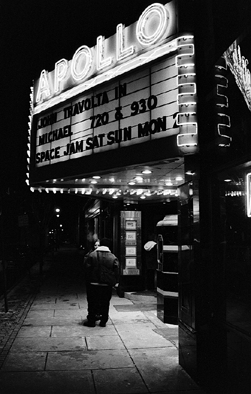








 Compared to the uncomfortable desks and lecture hall atmosphere in Kettering that has been the hallmark of Oberlin College's movie-going experience, the Apollo Theater is a refreshing alternative. The swank red leather seats, the neon marquee and the large curtained screen all contribute to a feeling of nostalgia for a bygone cinematic era.
Compared to the uncomfortable desks and lecture hall atmosphere in Kettering that has been the hallmark of Oberlin College's movie-going experience, the Apollo Theater is a refreshing alternative. The swank red leather seats, the neon marquee and the large curtained screen all contribute to a feeling of nostalgia for a bygone cinematic era.
Oberlin students dig the Apollo. "I like the atmosphere. I like the curtains. The walls are very nice," said junior Zachary Layton.
First-year Carey Maxon has taken a liking to the glowing clock that used to be an advertisement for a local bank. "It's this nice, mellowly-lit clock, and it's nice to be able to look at it during the movie," said Maxon.
Even though the decor of the Apollo is a major part of its appeal, the movies themselves are equally important. "Basically, the type of films students like has remained the same...I feel that the public in Oberlin craves good movies," said Arlene Steel, who helps run the Apollo.
In the early `50's, the Apollo also served as a stage for variety shows. In the early `50's, "Bank Nights" were a community event that provided an opportunity for local talent to perform in the theater. "Magicians would come in, we had a show. Once a week, we gave away money in a raffle," said Steel. There were also live performances featuring musical groups like Red Nickels and the Five Pennies. Birthdays were also a special occasion for the Steel family. "My father, when I was young, he'd have free shows on our birthday. He'd put on the marquee `Happy Birthday, Bill and Sandy'," Steel said.
The Apollo Theater has been around for almost 90 years. Although parts of the interior have been remodeled, the theater has essentially remained the same as it was in the 1930s. Before the thirties, the theater was smaller and only showed silent films. The building that houses the Apollo, the Hobbs Block, was built in 1913 by a local architect, Paul Rissman. It then went through a succession of owners until Jerry Steel bought the theater in 1928.
Jerry Steel transformed the small theater into a large movie house by adding more seats and providing the technology for films with sound. His twin sons, William and Sanders Steel, still run the theater today. According to a paper from 1975 by Oberlin student Harlan Shays, "Mr. Steel introduced `talkies' to Oberlin on May 11, 1929, so sound was still relatively new. The advertisement on November 14, 1929 proudly proclaimed an `All Talking Week' at the Apollo."
Many architectural aspects of the Apollo have remained untouched. The lobby, box office, wall fixtures, ticket machine and ticket containers are all original. However, there have been a few large changes. "Sometime after World War II, the marquee was changed from a rectangular shape to the triangular one you see now," said William Steel. The concession stand was also moved around the same time.
Considering the comparatively small population of Oberlin, the Apollo was an enormous movie theater. By 1936, there were about 900 seats, but the number of seats was reduced in 1953. William Steel said, "The screen was enlarged to accommodate Cinemascope movies," explained William Steel. "The seat capacity was reduced because the screen had to be brought out further." Changes in the film industry have had a large influence on the Apollo. "Years ago, we used to show a lot of foreign movies, but then we had more trouble getting them. Ingmar Bergman, a lot of those...Ingmar Bergman was a big money-maker," said Arlene Steel, William's wife. The Steels remember Ben Hur, the Star Wars trilogy, Fantasia and E.T. as some of the most memorable films that have been shown at the Apollo. The Steels try to please both the college students and the townspeople. "We try to get movies both people will like," said William Steel.
Since the invention of multiplex theaters, the Apollo has become a unique phenomenon. "There aren't too many theaters left like this. Most theaters have been twinned or quadrupled. There used to be eight or nine big theaters in Cleveland," said William Steel. The Apollo has finally been recognized nationally as the unique theater that it is. The January '96 issue of McCalls magazine featured the Apollo as one of the cheapest theaters in the country. There is a bar chart in the magazine comparing the Apollo with the likes of bigger chain theaters such as Sony Theaters in L.A. "We finally made the big time in McCalls. We don't get that kind of recognition usually," said William Steel.
It's come along way: Today's Apollo Theater still remains its magical past of vareity shows and birthday parties (photo by John Matney)

Copyright © 1997, The Oberlin Review.
Volume 125, Number 16; February 28, 1997
Contact Review webmaster with suggestions or comments at ocreview@www.oberlin.edu.
Contact Review editorial staff at oreview@oberlin.edu.